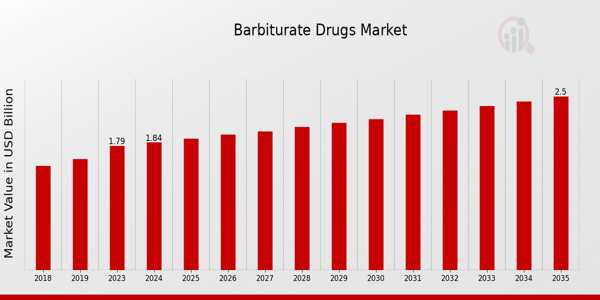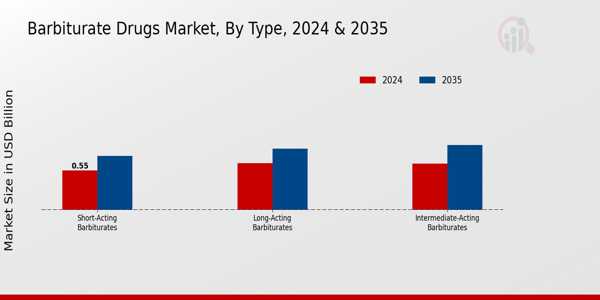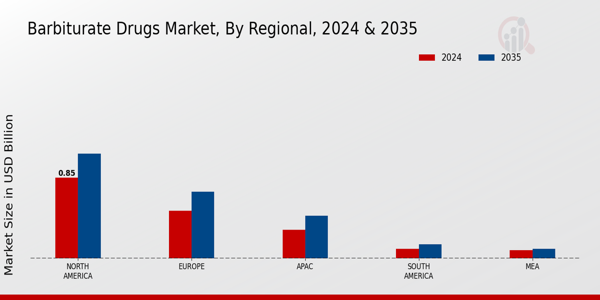Barbiturate Drugs Market Overview
As per MRFR analysis, the Barbiturate Drugs Market Size was estimated at 1.79 (USD Billion) in 2023.The Barbiturate Drugs Market is expected to grow from 1.84 (USD Billion) in 2024 to 2.5 (USD Billion) by 2035. The Barbiturate Drugs Market CAGR (growth rate) is expected to be around 2.83% during the forecast period (2025 - 2035).
Key Barbiturate Drugs Market Trends Highlighted
The rising prevalence of anxiety-related illnesses and sleep disturbances in the general population is one of the major factors influencing the global barbiturate drug market. The need for barbiturate drugs is increasing as more people look for efficient treatment alternatives.
The market has grown as a result of the creation of novel formulations and delivery systems that enable the more efficient treatment of a range of illnesses. Barbiturates are also more relevant in healthcare settings since surgical operations require sedation and anesthesia. There are a number of market opportunities that merit additional investigation.
The growing trend towards personalized medicine presents the potential for customized barbiturate treatments tailored to individual patient needs. Research into safer alternatives and the development of novel compounds can open new avenues for treatment options, thereby expanding the market landscape.
Collaborations between pharmaceutical companies and healthcare providers can lead to innovative solutions that improve patient outcomes while reducing the risks associated with barbiturate use.
In recent times, there has been a noticeable shift towards greater awareness of the potential risks and side effects of barbiturate medications. This has sparked a broader conversation about the importance of patient education and responsible prescribing practices.
Moreover, advancements in medical research are constantly changing the way barbiturates are perceived and utilized within healthcare. Increased regulation and monitoring by health authorities further shape the market dynamics, pushing for a balance between therapeutic benefits and safety concerns.
As these trends evolve, they will play a crucial role in shaping the future of the barbiturate drug market and influencing how these medications are integrated into patient care.

Source: Primary Research, Secondary Research, MRFR Database and Analyst Review
Barbiturate Drugs Market Drivers
Increasing Prevalence of Sleep Disorders and Anxiety-related Conditions
One of the most significant drivers for the Global Barbiturate Drugs Market is the rising incidence of sleep disorders and anxiety-related conditions among the global population.
Sleep disorders, including insomnia, obstructive sleep apnea, and restless leg syndrome, have seen a notable increase over the past few years, affecting millions of individuals worldwide. These conditions are often associated with stress, lifestyle changes, and an increasingly fast-paced world.
As a result, there is a growing need for effective pharmacological treatments. Barbiturates, known for their sedative and anxiolytic properties, are often prescribed to address these disorders. The ability of barbiturates to induce sleep and reduce anxiety makes them a go-to option for healthcare providers in managing these conditions.
Furthermore, as awareness regarding mental health grows, more individuals are seeking medical help, propelling the demand for these medications. This trend is likely to continue, contributing to sustained growth in the Global Barbiturate Drugs Market.
The interplay between psychological well-being, societal pressures, and the medicinal benefits of barbiturates is catalyzing a heightened demand for these drugs, which is anticipated to drive the market further in the coming years.
Growth in Geriatric Population
The growth in the geriatric population is another key driver for the Global Barbiturate Drugs Market. As the global population ages, there is an increasing prevalence of age-related health conditions, including chronic pain and mental health disorders.
Geriatric patients often require pharmacological therapies to manage their symptoms effectively. Given the sedative properties of barbiturates, they are frequently prescribed for sleep disorders and anxiolytic treatments in older adults.
Moreover, healthcare practitioners are more inclined to utilize barbiturates in clinical settings to ensure patients receive effective relief. This trend illustrates the strong correlation between demographic shifts and market demands, fueling growth in the Global Barbiturate Drugs Market.
Expansion of Healthcare Infrastructure in Emerging Economies
The expansion of healthcare infrastructure in emerging economies plays a vital role in driving growth in the Global Barbiturate Drugs Market. As these countries invest in improving healthcare access and quality, more patients are gaining access to necessary medications, including barbiturates.
The increased availability of healthcare services and heightened awareness regarding sleep disorders and mental health issues lead to a growing patient base that can be treated with barbiturate medications. Furthermore, as healthcare systems evolve to embrace better diagnostics and treatment plans, the demand for a wide variety of pharmaceuticals, including barbiturates, will likely see a parallel increase.
This development is crucial for the Global Barbiturate Drugs Market as it indicates a shift towards improved health and well-being in these regions.
Barbiturate Drugs Market Segment Insights :
Barbiturate Drugs Market Type Insights
The Global Barbiturate Drugs Market showcased a diverse range of products divided into different types, primarily including Short-Acting Barbiturates, Long-Acting Barbiturates, and Intermediate-Acting Barbiturates.
In 2024, the market valuation for Short-Acting Barbiturates reached 0.55 USD Billion, signifying a considerable share within the global market landscape. This category was crucial as it served immediate medical needs, being commonly utilized in procedures requiring quick sedation, thereby enhancing its importance in medical settings.
Following closely, Long-Acting Barbiturates held a market value of 0.65 USD Billion in 2024, making it a significant player as well. These medications were generally employed for sustaining longer-term sedation where continuous control of overactivity or prevention of seizure episodes is necessary, thus reflecting their indispensable role in therapeutic applications.
Furthermore, Intermediate-Acting Barbiturates possessed a market value of 0.64 USD Billion, placing them in a competitive position. This type had applications that bridge the gap between quick-acting and long-duration sedatives, allowing for flexibility in treatment approaches depending on patient needs.
The development and usage of these barbiturates reflected a trend towards tailored therapy, catering to various medical procedures and pharmacological needs.
Overall, as the Global Barbiturate Drugs Market continues to evolve, these segments not only demonstrate distinct roles but also affect market dynamics through their specific applications and therapeutic benefits, showcasing a complex interconnection of demand across the healthcare industry.
The versatility and efficacy of each barbiturate type contribute to the broader Global Barbiturate Drugs Market revenue, providing insight into the ongoing trends influencing this industry, including a possible rise in demand for sedation-related procedures and an expanding patient demographic requiring such medications.
Key elements driving the growth of the Global Barbiturate Drugs Market included advancements in clinical practices, increasing prevalence of conditions necessitating barbiturate usage, and the continuous evolution of related healthcare protocols.
However, this market segment also faced challenges, such as regulatory scrutiny and the advent of alternative treatments, which may affect the demand for traditional barbiturates. Yet, as the industry adapted, opportunities for growth remained as advancements in pharmaceuticals emerged, indicating that each type's specific role can remain pivotal in patient care within hospitals and clinics.
Additionally, the nuanced understanding of market segmentation fostered a strategic approach to addressing the needs dictated by evolving healthcare landscapes and patient requirements, with each type possessing a unique position within the broader framework of the Global Barbiturate Drugs Market, ensuring that their respective shares remain relevant and impactful in the years to come.

Source: Primary Research, Secondary Research, MRFR Database and Analyst Review
Barbiturate Drugs Market Application Insights
The application segment displays significant diversity, primarily focusing on Anesthesia, Sedation, Seizure Control, and Treatment of Insomnia.
Anesthesia is a critical application wherein barbiturates are utilized for inducing unconsciousness during surgical procedures, showcasing their essential role in modern medicine. Sedation also accounts for a substantial portion, as barbiturates help patients achieve calmness and relaxation.
Moreover, the market sees notable engagement in Seizure Control, where these drugs are effective in managing certain types of seizures, reflecting their therapeutic value. Treatment of Insomnia remains another important aspect, with barbiturates being employed to address sleep disorders, although their usage is declining due to the emergence of newer alternatives.
Overall, the diverse applications highlight the Global Barbiturate Drugs Market's revenue potential, as these medicines address specific medical needs and conditions, while simultaneously facing challenges from evolving market trends and patient preferences.
The Global Barbiturate Drugs Market data suggests that while barbiturates maintain a historical significance, ongoing developments in pharmaceutical options may influence their future standing within the Global Barbiturate Drugs Market statistics.
Barbiturate Drugs Market Route of Administration Insights
The Global Barbiturate Drugs Market has shown significant growth in the Route of Administration segment. This segment is critical, as it influences the efficacy and patient compliance of barbiturate drugs.
The most prevalent methods include Oral care, Intravenous, and Intramuscular administration. Oral administration remains a favored choice due to ease of use and patient preference, enhancing adherence to treatment regimens. Conversely, Intravenous administration is often preferred in clinical settings for rapid onset of action, particularly in acute medical situations.
Intramuscular administration, while less common, serves as a reliable alternative when intravenous access is challenging. Market trends indicate a shift towards more personalized medication delivery, increasing opportunities for innovations in these routes.
However, challenges such as regulatory hurdles and potential side effects of barbiturate medications may influence market dynamics. The Global Barbiturate Drugs Market revenue reflects the growing focus on optimizing these administration routes to improve patient outcomes and overall market growth.
As the market evolves, the segmentation within the Route of Administration will continue to play a vital role in addressing healthcare needs and driving development within the Global Barbiturate Drugs Market.
Barbiturate Drugs Market End Use Insights
The Global Barbiturate Drugs Market showcases a diverse segmentation focused on End Use. This sector plays a vital role in the overall market landscape, reflecting the critical nature of barbiturate drugs in medical settings.
Hospitals represent a significant portion, as these facilities rely on these medications for anesthetic and therapeutic purposes. Pharmacies also play a critical role, providing essential access to these drugs for outpatient care, thereby ensuring availability for chronic conditions requiring barbiturates.
Additionally, research laboratories are crucial, utilizing these drugs in scientific studies to deepen understanding of their effects and potential applications. The interplay between these segments is pivotal, with the increasing number of medical procedures and the rise in research activities driving market growth.
As the Global Barbiturate Drugs Market continues to evolve, trends such as the growing demand for effective pain management and sedation therapies are emerging as key growth drivers. However, challenges such as regulatory scrutiny and the development of alternative therapies may impact future trajectories.
Overall, the insights into the End Use segment underscore its importance in shaping the Global Barbiturate Drugs Market statistics and industry dynamics.
Barbiturate Drugs Market Regional Insights
The Regional analysis of the Global Barbiturate Drugs Market revealed significant variations in market valuation across various areas. In 2024, North America held the majority share with a valuation of 0.85 USD Billion, reflecting its dominant role in the Barbiturate Drugs Market due to advanced healthcare infrastructure and high demand for sedative medications.
Europe followed with a valuation of 0.5 USD Billion, showing notable involvement, particularly in regulatory frameworks supporting the market. The APAC region, valued at 0.3 USD Billion, emerged as a significant player, driven by an increase in healthcare spending and growing awareness of mental health issues.
South America and MEA demonstrated smaller market valuations, at 0.1 USD Billion and 0.09 USD Billion respectively, indicating they were in the nascent stages of development in the barbiturate segment but possessed potential for growth due to rising healthcare access and changing medical practices.
The overall landscape revealed a shift towards recognizing the therapeutic benefits of barbiturates in managing various conditions, thus driving market growth across all regions.

Source: Primary Research, Secondary Research, MRFR Database and Analyst Review
Barbiturate Drugs Market Key Players and Competitive Insights :
The Global Barbiturate Drugs Market is characterized by a diverse range of players, each vying for market share through innovative product offerings and strategic positioning. The market encompasses a variety of segments, including the production of short-acting, intermediate-acting, and long-acting barbiturates, which are primarily used for their sedative, anesthetic, and anticonvulsant properties.
The competitive landscape is influenced by factors such as regulatory compliance, advancements in formulation technologies, and ongoing research and development activities aimed at improving the efficacy and safety profiles of barbiturate drugs.
Companies operating in this space must navigate the challenges of patent expirations, the emergence of generics, and evolving healthcare regulations while striving to meet the growing demand for these medications across various therapeutic areas.
Mylan maintains a significant presence in the Global Barbiturate Drugs Market, leveraging its strong portfolio and established distribution networks to cater to a broad clientele. The company is recognized for its commitment to quality and affordability, enabling it to effectively compete with both branded and generic counterparts.
Mylan's strengths include a robust research and development pipeline, which focuses on optimizing existing formulations and introducing new barbiturate products that resonate with evolving patient needs. The company's operational efficiency and supply chain management further enhance its competitiveness, allowing it to quickly respond to market trends and regulatory requirements.
Mylan's strategic partnerships and collaborations with healthcare stakeholders bolster its market reach and brand reputation, creating a strong foundation for sustained growth within the barbiturate segment.
Teva Pharmaceutical has carved out a notable position in the Global Barbiturate Drugs Market, known for its extensive experience in the pharmaceutical industry and a broad spectrum of generic and specialty products.
The company's strengths lie in its diverse product pipeline, which includes several barbiturate formulations aimed at addressing various medical conditions. Teva’s global footprint and well-established sales capabilities enable it to penetrate different geographies effectively, ensuring access to its barbiturate therapies in multiple markets.
The company's commitment to research and development supports its ability to innovate as it continuously seeks to enhance the therapeutic benefits and safety profiles of its offerings. Teva Pharmaceutical's focus on regulatory compliance and high manufacturing standards further strengthens its market position, fostering trust among healthcare providers and patients alike.
Key Companies in the Barbiturate Drugs Market Include:
Mylan
Teva Pharmaceutical
Fresenius Kabi
Mallinckrodt
Sun Pharmaceutical
Elemental Pharmaceuticals
Hikma Pharmaceuticals
AbbVie
Boehringer Ingelheim
Sanofi
Afton Chemical
Eisai
AstraZeneca
GSK
Barbiturate Drugs Market Developments
Recent developments in the Global Barbiturate Drugs Market have highlighted significant changes and trends among key players. Mylan and Teva Pharmaceutical have shown ongoing competitiveness in pricing strategies, which is crucial as hospitals increasingly seek cost-effective solutions for anesthesia and sedation.
Meanwhile, Fresenius Kabi and Mallinckrodt have made strides in diversifying their product offerings within the barbiturate category, responding to growing demand for short-acting anesthetics. Sun Pharmaceutical and Elemental Pharmaceuticals have engaged in strategic partnerships to enhance access to essential barbiturates in emerging markets.
Recent activity also saw Hikma Pharmaceuticals expanding its manufacturing capabilities to meet surging demand, while AbbVie and Boehringer Ingelheim are reportedly investing in research to innovate delivery systems for existing barbiturate medications.
AstraZeneca and GSK have maintained robust pipelines in centralized and decentralized clinical trials, focusing on safety and efficacy to boost market confidence. The market valuation of these companies is positively impacted by these advancements, with increased investments leading to heightened activity and larger market shares among participants.
This competitive landscape is expected to drive further innovation and growth in the Global Barbiturate Drugs Market.
Barbiturate Drugs Market Segmentation Insights
Barbiturate Drugs Market Type Outlook
- Short-Acting Barbiturates
- Long-Acting Barbiturates
- Intermediate-Acting Barbiturates
Barbiturate Drugs Market Application Outlook
- Anesthesia
- Sedation
- Seizure Control
- Treatment of Insomnia
Barbiturate Drugs Market Route of Administration Outlook
- Oral
- Intravenous
- Intramuscular
Barbiturate Drugs Market End Use Outlook
- Hospitals
- Pharmacies
- Research Laboratories
Barbiturate Drugs Market Regional Outlook
- North America
- Europe
- South America
- Asia Pacific
- Middle East and Africa
| Attribute/Metric Source: |
Details |
| MARKET SIZE 2023 |
1.79 (USD Billion) |
| MARKET SIZE 2024 |
1.84 (USD Billion) |
| MARKET SIZE 2035 |
2.5 (USD Billion) |
| COMPOUND ANNUAL GROWTH RATE (CAGR) |
2.83% (2025 - 2035) |
| REPORT COVERAGE |
Revenue Forecast, Competitive Landscape, Growth Factors, and Trends |
| BASE YEAR |
2024 |
| MARKET FORECAST PERIOD |
2025 - 2035 |
| HISTORICAL DATA |
2019 - 2024 |
| MARKET FORECAST UNITS |
USD Billion |
| KEY COMPANIES PROFILED |
Mylan, Teva Pharmaceutical, Fresenius Kabi, Mallinckrodt, Sun Pharmaceutical, Elemental Pharmaceuticals, Hikma Pharmaceuticals, AbbVie, Boehringer Ingelheim, Sanofi, Afton Chemical, Eisai, AstraZeneca, GSK |
| SEGMENTS COVERED |
Type, Application, Route of Administration, End Use, Regional |
| KEY MARKET OPPORTUNITIES |
Growing geriatric population demand, Increased prevalence of sleep disorders, Rising anesthesia applications in surgeries, Expanding market for mental health therapies, Opportunities in emerging markets |
| KEY MARKET DYNAMICS |
Regulatory pressures on manufacturing, Rising prevalence of sleep disorders, Increasing awareness of mental health, Shift towards alternative therapies, Patent expirations impacting pricing |
| COUNTRIES COVERED |
North America, Europe, APAC, South America, MEA |
Frequently Asked Questions (FAQ) :
The Global Barbiturate Drugs Market is expected to be valued at 1.84 USD Billion in 2024.
By 2035, the Global Barbiturate Drugs Market is projected to reach a value of 2.5 USD Billion.
The expected CAGR for the Global Barbiturate Drugs Market from 2025 to 2035 is 2.83%.
In 2024, North America is projected to have the highest market value at 0.85 USD Billion.
Short-Acting Barbiturates are expected to be valued at 0.55 USD Billion in 2024.
The market size for Long-Acting Barbiturates is projected to be 0.85 USD Billion by 2035.
Major players in the Global Barbiturate Drugs Market include Mylan, Teva Pharmaceutical, and Fresenius Kabi.
Intermediate-Acting Barbiturates are expected to have a market value of 0.64 USD Billion in 2024.
The projected market value for the APAC region in 2035 is 0.45 USD Billion.
The market faces challenges such as regulatory changes and competition from alternative therapies.

















